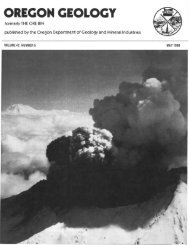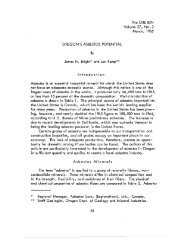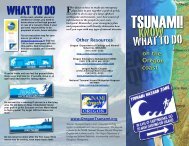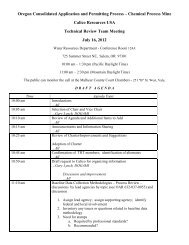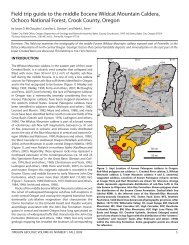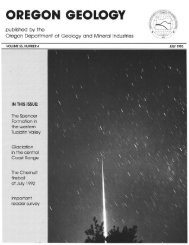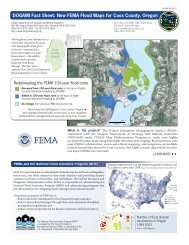Ore Bin / Oregon Geology magazine / journal - Oregon Department ...
Ore Bin / Oregon Geology magazine / journal - Oregon Department ...
Ore Bin / Oregon Geology magazine / journal - Oregon Department ...
Create successful ePaper yourself
Turn your PDF publications into a flip-book with our unique Google optimized e-Paper software.
Discussion<br />
It is difficult to identify unassociated fossil sharks teeth; to do so<br />
requires a thorough understanding of the variability of tooth morphology<br />
among species of modern sharks and rays. Teeth may be individually examined<br />
for the presence or absence of the following general features: crown<br />
and root shape; position of nutrient canals; serrations on the crown and<br />
dentic les; number of lateral denticles; tooth size; and flexures in the crown.<br />
Any number of these characteristics may require critical examination in<br />
order to segregate teeth of different species.<br />
Variations in tooth morphology may be observed within the jaws of<br />
almost any modern shark or ray. Teeth of a single species may differ in<br />
the upper and lower jaw or laterally in a single tooth row. Tooth variation<br />
also occurs as a result of age and sexual dimorphism. In order to establish<br />
valid taxa when working with unassociated fossil teeth, it is necessary<br />
to construct entire tooth sets which define the total range of variation within<br />
the species. This technique has proven to be useful for the interpretation of<br />
large faunas in California and is presently being applied to <strong>Ore</strong>gon sharks<br />
and rays.<br />
The paucity of some of the faunas previously described is for the most<br />
port apparent rather than real. It is due to the nature and conditions of<br />
deposition of the sediments and does not accurately represent the characteristics<br />
of the actual biotic community. The physical conditions of sedimentation<br />
and biologically limiting factors in the environment directly<br />
influence the resultant fossil assemblage. Where active transport or agitation<br />
of sediments occurs during deposition, organic remains may be subjected<br />
to severe abrasion, often resulting in the accumulation of clastic shell<br />
debris and total destruction of all softer parts. Sorting of teeth may occur<br />
as a result of strong current action, and post-depositional leaching by<br />
ground water can destroy tooth dentine. The latter best describes the conditions<br />
which must have existed during the formation of the Helmick Hill<br />
shark tooth bed. Only rarely do <strong>Ore</strong>gon localities yield nontransported<br />
shark material. However, excellent undisturbed faunas have been obtained<br />
from a few outcrops of the Coaledo, Nestucca, and Keasey Formations.<br />
Summary<br />
The purpose of this paper is to give some account of the fossil shark<br />
faunas of <strong>Ore</strong>gon. This has been, at best, only introductory to the more<br />
than 5,000 specimens now being studied by the author. Many of the genera<br />
are listed in Figure 2, but species determinations have not yet been completed.<br />
In most instances, more than one species exists for each genus listed.<br />
Newly developed localities are continuing to yield more material, and it is<br />
hoped that each of the faunas mentioned herein wi II be treated in full at a<br />
later date.<br />
169





